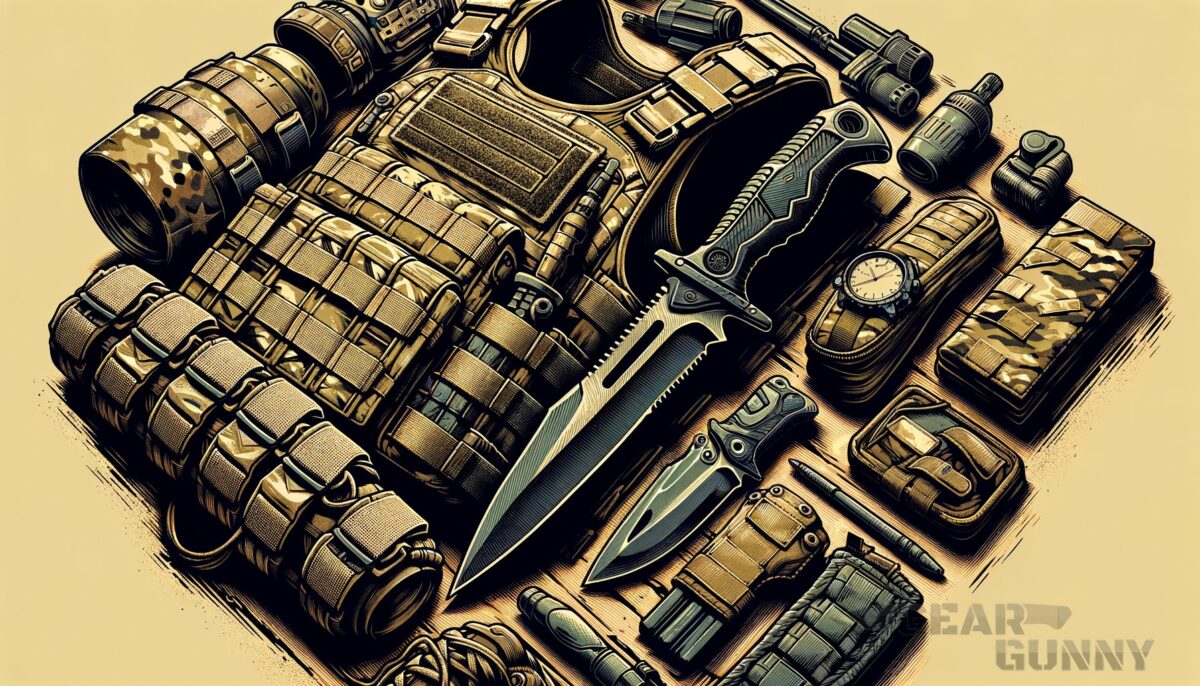Are you packing the right protection to ensure your safety in a close-quarters scenario? Ever wondered about the effectiveness of your body armor against a knife attack? Does your plate carrier stand a chance against a blade?
In this post, you’ll learn all about the relationship between body armor and edged weapons. Check out some of the best plate carriers to get started on your safety gear.
Key takeaways
- Body armor needs to be stab-resistant to effectively stop knife attacks.
- Dual-threat vests can provide protection against both bullets and blades.
- Pairing suitable gear with regular training is essential for personal defense.
Will body armor stop a knife?
Contrary to what one might think, not all body armor is designed to stop a knife. The truth is, body armor comes in different levels of protection and is primarily classified to stop bullets, not necessarily stabs or slashes. While a bullet-resistant vest could potentially slow down a knife, it lacks the more reinforcement to guarantee protection against blade penetration.

However, there are specialized vests known as stab-resistant armor that incorporate materials like chainmail or special fibers to resist knife attacks. These are designed with corrections officers and other at-risk personnel in mind. So, if you’re concerned specifically about knives, you’ll want to invest in this particular type of gear.
Here’s a breakdown of when body armor may or may not stop a knife: * Ballistic-only vests: Not reliable for knife protection. * Stab-resistant vests: Specifically designed to protect against stabbings. * Dual-threat vests: Offer both bullet and stab protection.
The performance of these vests varies, and choosing the right one depends on your specific needs. Also, adding tactical gloves can add an extra layer of defense for your hands during a confrontation.
Just my two cents, but I reckon body armor isn’t some magical force field, devil dog. You’ve got to choose the right gear for the threat you’re up against, and that’s just the ground truth. Now, I’m no lab scientist with all the fancy numbers, but I definitely know my gear.
Take it from a story I heard back when I was a fresh boot. A fellow Marine had a run-in during a training session where his buddy’s life was saved thanks to stab-resistant armor. Slashes came at him like he was caught in a thicket, but that armor kept him intact.
Just like that scene from “Saving Private Ryan,” where a knife fight shows just how dire it can get without proper protection. It’s a grim reminder – movies or not – always make sure you’re geared up right. It’s not just about stopping bullets; it’s about being prepped for every kind of scrap.
Check out some rough and ready survival knives for the flip side of this coin.
5.11 Rush 24 Tactical Backpack

5.11 Rush 24 Tactical Backpack
Understanding body armor types
Body armor isn’t one-size-fits-all when it comes to protection. There are diverse types tailored to specific threats. Ballistic vests, for example, are rated by the National Institute of Justice (NIJ) with levels to signify the caliber of bullet they can stop.
However, they might not hold up against a sharp blade.
Knowing you have the right protection can be a significant confidence booster in the field. It’s not just about stopping bullets; it’s about being fully prepped for any kind of scrap that comes your way. Always ensure you’re suited up for the threat at hand.
Ballistic protection levels
Ballistic armor comes with various levels of protection. NIJ levels IIA, II, IIIA, III, and IV each indicate what caliber of gunfire they can withstand. Lower levels handle smaller calibers, while the highest, level IV, is designed to stop armor-piercing rifle rounds.

For more on firearm specifics, learn how loud is a 5.56 round.
Stab resistance
In contrast, stab-resistant vests are designed differently to prevent injuries from knife attacks. Their construction focuses on preventing sharp tips from penetrating, using tightly woven, high-strength fibers, or other reinforced materials. It’s this special design that gives them their protective qualities against edged threats.
Adding the right gear for blade threats
Not all dangerous encounters will involve firearms. Knives and other sharp objects are common risks, especially in close combat scenarios or crowded urban environments.
The importance of stab-resistant armor
Body armor designed to stop bullets may not protect you from getting stabbed. Stab-resistant vests apply specifically to these threats. Choosing a vest that offers both ballistic and stab protection is key if you’re likely to face both types of threats.
Sequencing your gear properly is as crucial as knowing what BOLO mean in military operations.
Dual-threat protection
Manufacturers have developed vests that combine features of both ballistic and stab-resistant types, referred to as dual-threat armor. This armor provides versatile protection without the need to don separate pieces of equipment for different threat types, which is essential in fluid, unpredictable situations.
Enhancing personal defense measures
Body armor is a critical component of personal safety for military and law enforcement personnel. Still, relying solely on gear isn’t enough. Other measures need to be integrated into personal defense strategies.
Tactical accessories for defense
Alongside a stab or ballistic resistant vest, including tactical accessories such as tactical gloves, belts, and boots can be lifesaving. They not only provide added protection but also improve agility and grip, necessary for self-defense.
Defense tactics training
Equipping yourself with body armor is just the beginning. Training in defensive tactics to handle knife attacks effectively is paramount. This training equips you with the skills to potentially avoid using lethal force and neutralize threats swiftly.
Selecting the right armor for your needs
It’s not enough to simply purchase what seems to be the strongest armor available. Your choice should be determined by the typical threats you’re likely to encounter and your mobility requirements.
Assessing threat levels and mobility
Consider the balance between protection and mobility. Higher levels of armor provide greater protection but can be bulkier and heavier, reducing mobility. This decision is critical and should be informed by your mission profile or daily duties.
The role of plate carriers
Plate carriers offer modular protection, allowing you to adjust the level of armor you’re carrying based on your assessment of the threat level and need for mobility. They’re a practical choice for those who may face varying threat levels. Dive into the qualities of the best plate carriers to make an informed selection.
Before we look at a data table summarizing key points about body armor and knife resistance, remember that no gear can guarantee 100% safety. It’s always about increasing your odds in the face of danger, whether that’s from a ballistic threat or a blade.
Types of body armor and their effectiveness against knives
| Armor Type | Protection Against Bullets | Protection Against Knives | Best Used For |
|---|---|---|---|
| Ballistic-only | Yes | No | Gun-related threats |
| Stab-resistant | No | Yes | Knife and spike-related threats |
| Dual-threat | Yes | Yes | Mixed-threat environments |
A comparison of armor types and their distinct protective capabilities.
More body armor tips
When it comes to personal safety and tactical readiness, there’s more to consider than simply strapping on body armor. Here are a few actionable tips to bolster your protection level and ensure you’re as prepared as possible for any scenario.
- Understand your mission requirements: Define the threat level you’re likely to face and choose armor that aligns with those threats.
- Maintain your armor: Regularly inspect and care for your vests to keep them in top condition.
- Train with your gear on: Being comfortable and mobile in your armor is as important as the protection it provides.
- Stay updated on new technologies: Armor technology is always advancing. Stay informed to ensure you have the best available protection.
- Consider covert options: If discretion is key, there are covert vests that can be worn under clothing.
- Tailor your gear: Augment your protection with tactical gloves, boots, and helmets as needed.
For those looking to maximize their use of body armor, follow these dos and don’ts to make the most out of your protective gear.
Dos and don’ts of using body armor
| Do | Don’t |
|---|---|
| Fit your armor correctly to your body | Neglect the care and maintenance |
| Regularly train in your armor | Overlook the weight and mobility trade-offs |
| Upgrade your armor as better options emerge | Ignore the expiration date of the armor panels |
| Use more protective accessories | Rely solely on your armor for protection |
A guide to the best practices for utilizing body armor effectively.

Advantages and disadvantages of using body armor
Body armor is a fundamental component of personal security, especially in professions that involve a higher risk of facing violent situations. It provides life-saving protection but it’s not without its trade-offs.
Advantages
- Increased survival rates: Body armor repeatedly proves its value in saving lives against ballistic and edged weapon threats.
- Deterrent effect: The visible presence of armor can act as a deterrent to potential assailants.
- Confidence in the field: Knowing you have protection can increase confidence and focus during high-pressure situations.
- Modular options: With plate carriers, you can tailor protection levels for different scenarios.
Disadvantages
- Limited protection: Armor may not offer complete protection against all threats, particularly high-caliber or powerful stabbing attacks.
- Decreased mobility: The added weight and bulk can hinder agility and endurance.
- Heat and discomfort: Extended wear, especially in hot climates, can lead to overheating and even injury.
- Maintenance and cost: High-quality armor requires an investment and ongoing maintenance, which can be costly.
If you are a visual learner, check out this video titled ‘Are BulletSafe Bulletproof Vests Also Stab-Proof?’
Frequently asked questions (FAQ)
How do I know if my body armor has expired?
Regular wear and exposure to the elements can degrade the protective materials in body armor over time. Manufacturers typically provide a warranty period and an expiration date. It’s crucial to check this date and replace your armor accordingly to ensure its effectiveness.
Can body armor be repaired if it gets damaged?
Once body armor has sustained any significant damage, it’s integrity can be compromised. This includes not only actual punctures but also severe abrasions or deformations. It’s safer to replace damaged armor rather than attempting to repair it.
Is it legal for civilians to own body armor?
In the United States, it is generally legal for civilians to purchase and own body armor. However, there are some state-specific regulations, and convicted felons are prohibited from owning body armor. Always check local laws before purchasing.
Final thoughts
In the end, whether your armor can stop a knife comes down to choosing the correct type for the threats you face. Body armor technology is always advancing, and staying informed is your best bet for safety. Pairing the right gear with proper training can make all the difference when the moment of truth arrives.
Stay safe and stay prepared.
How confident do you feel now about your knowledge of body armor’s effectiveness against knife attacks? Did I cover everything you wanted to know? Let me know in the comments section below I read and reply to every comment.
If you found this article helpful, share it with a friend, and check out my full blog for more tips and tricks on tactical and self-defense gear. Thanks for reading and stay on target out there.















